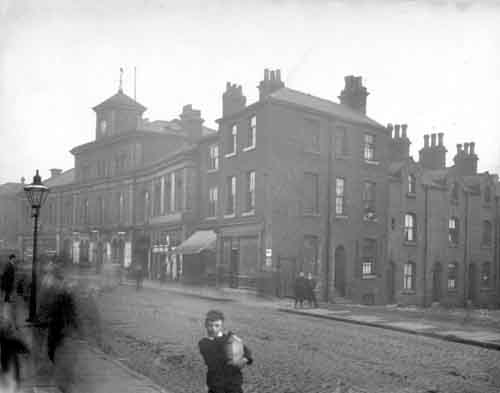The North Street area of Leeds is a bit of an inner city nowhere-land these days. Few people live there, and a recent visit one afternoon finds it largely bereft of pedestrians. Very little of the original nineteenth-century built environment remains, though one curious survivor does still stand. With its elegant classical frontage cleaned and restored the building in question looks prim, almost sterile. One can imagine it having been a high-class drapery shop, or an insurance office, or even a non-conformist chapel. But it actually started out life as a pub, and it appears to have been a very lively one at that.

The former Smithfield Hotel, North Street. By Tim Green
Built in 1861, the Smithfield Hotel was named after the Smithfield Cattle Market which then occupied the land opposite that is now called Lovell Park. In those days it was commonplace for livestock to be driven through city streets, and the market held a Cattle Fair twice a week when some 500 heads of cattle, and 4,000 sheep and lambs might be displayed. There was also a General Fair half-yearly and the Great Show of the Smithfield Club annually.
The Smithfield’s bars must have regularly been thronged with farmers and drovers and dealers and auctioneers. The densely populated surrounding area provided a large potential customer-pool too, accommodating as it did the maze of overcrowded dwellings and tailoring sweatshops that constituted the Leylands. And the hotel backed onto the extensive Smithfield Ironworks of engineering firm Thomas Green & Sons.

Smithfield Hotel 15th April 1897. By kind permission of Leeds Library and Information Services, www.leodis.net
Surmounted by a tower, fitted with an illuminated clock, the place was a sizable and imposing establishment. On the ground floor it had a vaults, a taproom, a snug, a main bar and a kitchen. The first floor had a billiard room, three sitting rooms, and a bathroom. Spacious ale, spirit and coal cellars were in the basement, and outside was a brew-house, a coach house and a stable block. On the second floor were six bedrooms, though the hotel does not seem to have been primarily residential. No paying guests are recorded as staying there on census night in 1871, when John Maude, the Hotel Keeper, was in residence with his wife Bessy and their daughters Polly, Annie, Isabel and Emily. A cook, a house maid, a groom and a waiter also lived-in.
Sufficient event occurred there from time-to-time to involve the courts and to excite press interest. One evening in 1866, a knife changed hands in the taproom that was later-on used to desecrate St. Matthew’s Church in nearby Little London. In 1868, a tramp who loitered about “that excellent hostelry” and was given to sleeping in its brew-house, fell into a beer-vat of boiling water and was scalded to death. In 1876, a drover enjoying a glass of beer there trod on the paw of a retriever lying under his settle and was badly bitten by the dog, which turned out to have rabies. He contracted “the usual symptoms of madness [hydrophobia] and he died in great agony”.
In 1885 the then landlord, Councillor William Metcalfe, was attacked with a stick in his own bar by an obscenity-spouting drunk. In court the offender quoted extensively from the Psalms, which did not prevent him being jailed for three months. In 1894 William Fawcett, who succeeded Metcalfe as publican, was summoned for having permitted music to be played on the premises without a licence. In 1903, Fawcett endured a night-time kitchen fire at the hotel that caused significant damage.
Of course, the place was not wholly subject to untoward happenings. It also hosted a wide range of social activities. A Four-in-hand club met there, before setting off on country outings. Messrs Oliver & Appleton, auctioneers of Albion Place, regularly held land sales by auction in one of the upstairs sittings rooms, and sales of all kinds of property were advertised to take place on the premises. Public meetings on contentious issues of the day were conducted there, as were political debates at election times. Billiard competitions were popular, and the Smithfield Club conducted its general proceedings and planned its livestock shows there.
By 1886, having such a noisome facility as a cattle market in the central area come to be considered an inconvenient nuisance by the city fathers and it was closed, its home being transferred to Gelderd Road. The five-acre site was then converted into the Recreation Ground that is now Lovell Park. The Smithfield Hotel had been much frequented by those having business at the market, and it is likely that the place was never the same again. It was finally closed as licensed premises in 1927, probably suffering from a further loss of clientele as more prosperous elements moved northwards out of the Leylands into Chapeltown.
Later, it was for long the entrance block to Thomas Green & Son’s Ironworks which, in turn, closed down in 1975. Despite its striking appearance, the former hive of local life seems strangely invisible in its present incarnation as offices. It sits there rather forlornly, unnoticed by passing motorists and bus passengers and largely unremarked upon in folk memory.
Sources:
Books: “The Changing Face of Leeds”, B. Godward; “Jackson’s Guide to Leeds”, R. Jackson; “Leeds. A Historical Dictionary of People, Places and Events”, D. Thornton; “A History of Modern Leeds”, ed., D. Fraser; “Images of Leeds (1850-1960)”, P. Brears.
Newspapers: Leeds Intelligencer: 23/6/1866. Yorkshire Post & Leeds Intelligencer: 31/10/1874; 31/11/ 1874; 6/4/1875; 25/6/1886; 16/7/1927. Leeds Times: 21/9/1861; 28/9/1861; 4/7/1868; 7/2/1885. Yorkshire Evening Post: 30/5/1894; 10/11/1903. Leeds Mercury: 31/8/1861; 25/9/1862; 4/7/1868; 12/6/1876; 7/11/1903; 31/12/1903.
Leeds Directories: White’s (1866); Porter’s (1872); Kelly’s (1881, 1900, 1904, 1927, 1929).
1871 Census.
